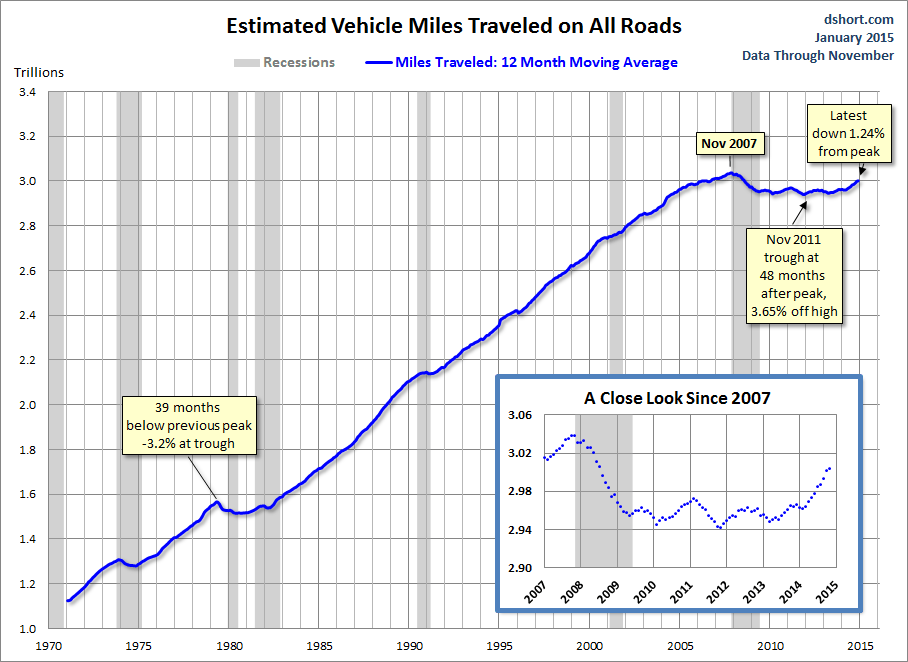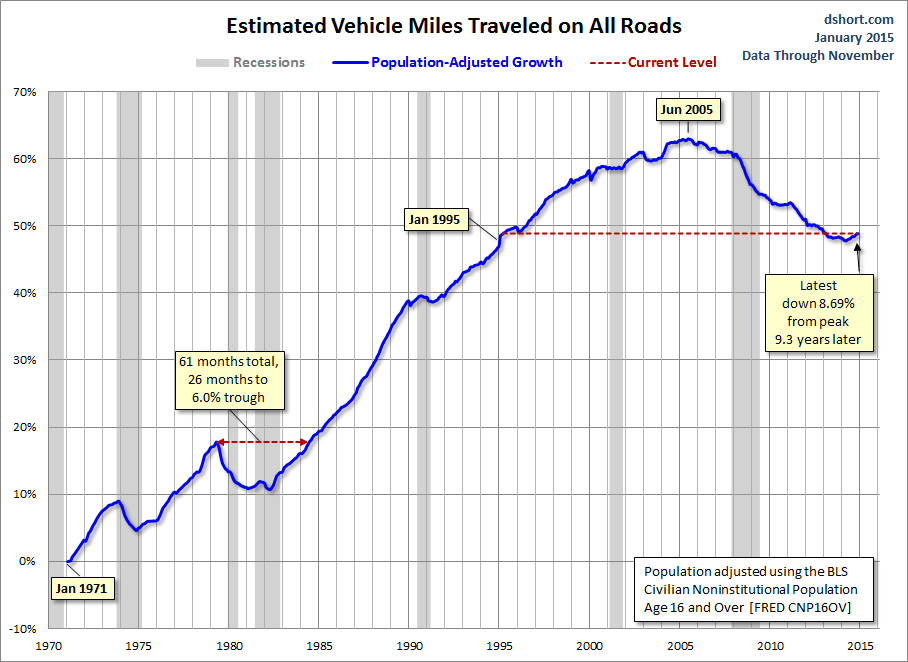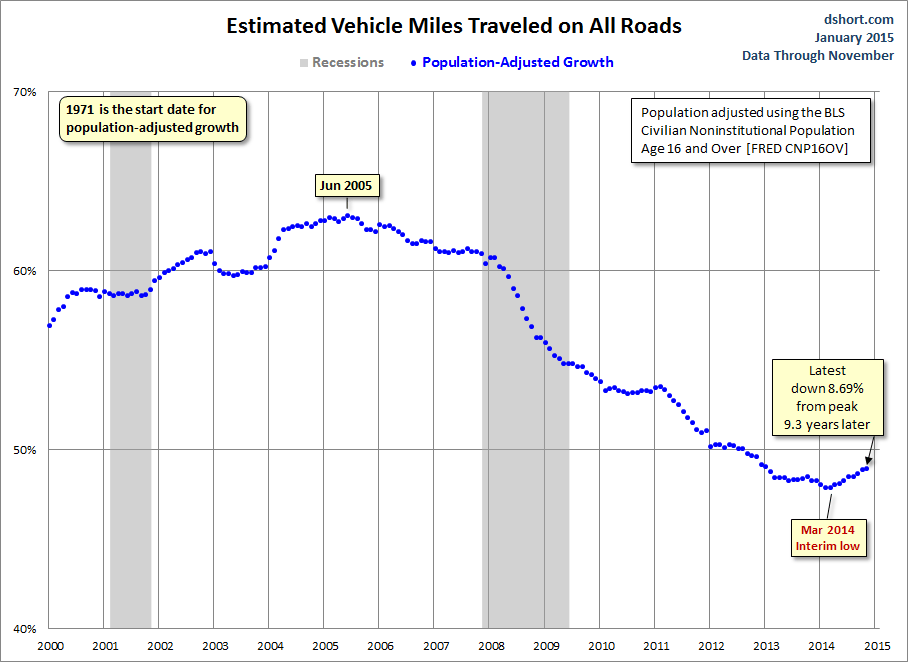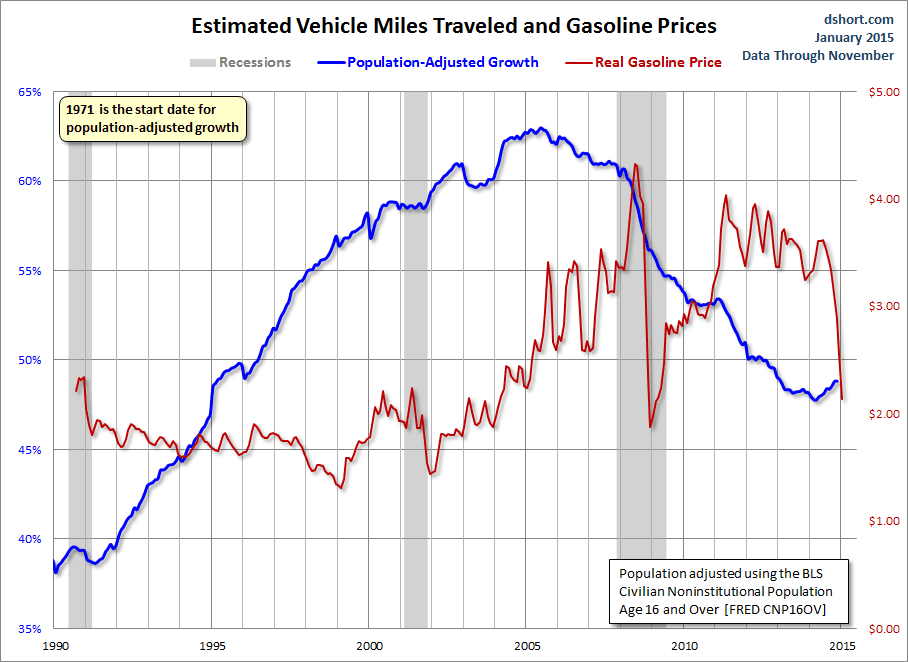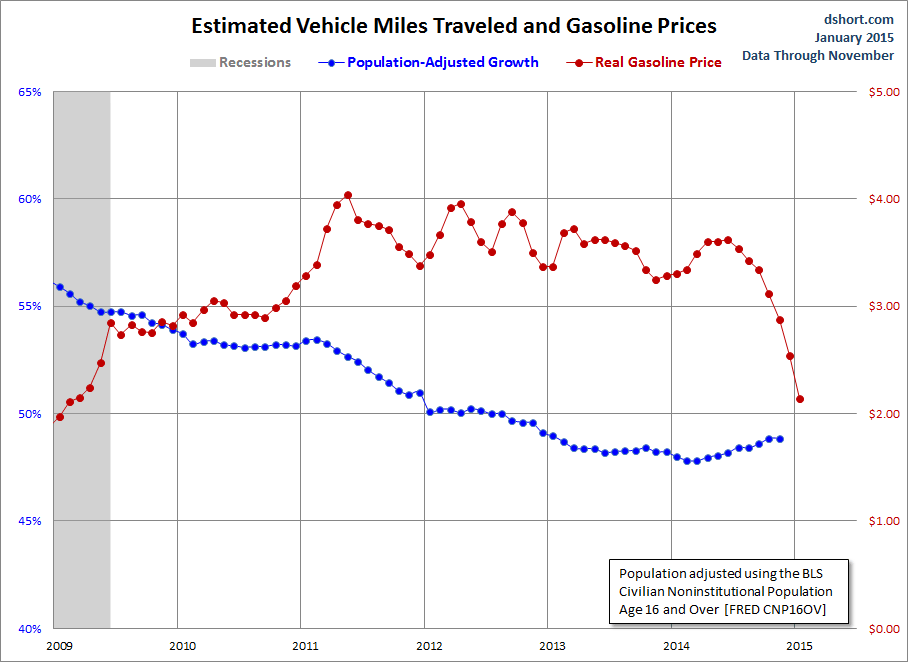The Department of Transportation's Federal Highway Commission has released the latest report on Traffic Volume Trends, data through November.
"Travel on all roads and streets changed by 1.1% (2.5 billion vehicle miles) for November 2014 as compared with November 2013" (see report).
The less volatile 12-month moving average is up 0.08% month-over-month and 1.35% year-over-year. If we factor in population growth, the 12-month MA of the civilian population-adjusted data (age 16-and-over) is essentially unchanged, up 0.01% month-over-month and up only 0.42% year-over-year.
Here is a chart that illustrates this data series from its inception in 1970. I'm plotting the "Moving 12-Month Total on ALL Roads," as the DOT terms it. My start date is 1971 because I'm incorporating all the available data from earlier DOT spreadsheets. The FRED repository has the series from 1987 to the latest update. As we can readily see, the post-recession pattern suggests a structural change in our driving habits.
The rolling 12-month miles traveled contracted from its all-time high for 39 months during the stagflation of the late 1970s to early 1980s, a double-dip recession era. The most recent decline has lasted for 84 months and counting — a new record, but the trough to date was in November 2011, 48 months from the all-time high.
The Population-Adjusted Reality
Total Miles Traveled, however, is one of those metrics that should be adjusted for population growth to provide the most meaningful analysis, especially if we want to understand the historical context. We can do a quick adjustment of the data using an appropriate population group as the deflator. I use the Bureau of Labor Statistics' Civilian Noninstitutional Population Age 16 and Over (FRED series CNP16OV). The next chart incorporates that adjustment with the growth shown on the vertical axis as the percent change from 1971.
Clearly, when we adjust for population growth, the Miles-Traveled metric takes on a much darker look. The nominal 39-month dip that began in May 1979 grows to 61 months, slightly more than five years. The trough was a 6% decline from the previous peak.
The population-adjusted all-time high dates from June 2005. That's well over nine years ago. The latest data is 8.68% below the 2005 peak, fractionally off the -9.22% post-Financial Crisis low in March of 2014. Our adjusted miles traveled based on the 16-and-older age cohort is about where we were as a nation in March of 1995.
Here is a closer look at the series since 2000. We can see that the decline leveled off in 2010, rolled over in 2011, leveled off in the first half of 2012 and then rolled over again.
About that Population Adjustment…
I've often been asked why I use the CNP16OV data for the population adjustment, often with the suggestion that it would make more sense to limit the population to licensed drivers. For openers, I don't know of a valid source for the driver-licensed population. But more importantly, the correlation between license holders and actual drivers is far from reliable. Many license holders in households do not drive, especially in their older years. According to Census Bureau data on gasoline sales (courtesy of Harry Dent's research on demand curves), dollars spent on gasoline peaks for people in their late 40s and falls off rather quickly after that.
In fact, I think there's a good case for using the Census Bureau's mid-month estimates of total population (POPTHM) rather than civilians age 16 and over for the population adjustment. The reason is that a portion of total miles traveled is specifically to support children's needs (day care, schools, children's activities, etc.) and the needs of elders who might have licenses but no longer drive. Ultimately the division of miles traveled by either population group (CNP16OV or POPTHM), while not a perfect match with drivers, is a consistent and relevant metric for evaluating economic growth.
Here is the same population-adjusted chart, this time with the total population for the adjustment. In the total-population adjusted version the latest data point of -6.9%, a bit off the -7.7% post-recession low seven months earlier.
What about the impact of volatile gasoline prices? How much of a factor has that been in the trend? I'll close with an overlay of the population-adjusted miles traveled and real (inflation-adjusted) regular gasoline prices (all formulations) since the early 1990s.
Here is a closer look at miles traveled and gasoline prices since the end of the recession.
As is readily apparent, the correlation is fairly weak over the entire time frame. And, despite the volatility in gasoline prices since the onset of the Great Recession, the correlation since December 2007 has been even weaker. That said, the 2014 decline in gasoline prices has been accompanied by a rise in miles traveled.
In the big picture, there are profound behavioral issues apart from gasoline prices that are influencing miles traveled. These would include the demographics of an aging population in which older people drive less, continuing high unemployment, the ever-growing ability to work remote in the era of the Internet and the use of ever-growing communication technologies as a partial substitute for face-to-face interaction.
See the recent study by the Frontier Group, A New Direction: Our Changing Relationship with Driving and the Implications for America's Future (PDF format).
The Driving Boom — a six decade-long period of steady increases in per-capita driving in the United States — is over.
Americans drive fewer total miles today than we did nine years ago, and fewer per person than we did at the end of Bill Clinton's first term. The unique combination of conditions that fueled the Driving Boom — from cheap gas prices to the rapid expansion of the workforce during the Baby Boom generation — no longer exists. Meanwhile, a new generation — the Millennials — sees a new American Dream that is less dependent on driving.
See also my report on Driving Declines in America's Cities, which highlights research in a recent report by U.S. PIRG Education Fund.
See also the latest U.S. PIRG report on "Millennials in Motion: Changing Travel Habits of Young Americans", which I discuss here.
The DOT "miles traveled" metric is also interesting to study in the context of gasoline volume sales, which I also update monthly:

